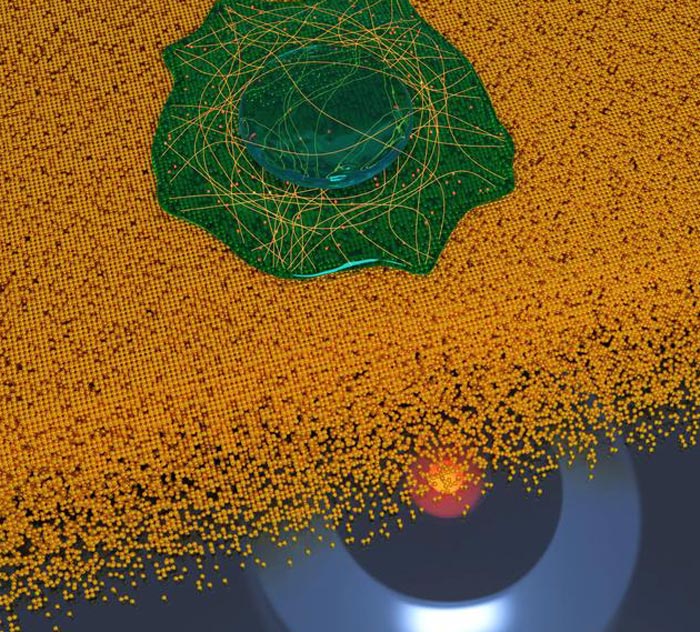Microscopy technique enables 3D super-resolution nanometre-scale imaging

To show that 3D imaging with MIET-SMLM is compatible with biological samples, cells were seeded on a cover glass coated with 10 nm of gold and 5 nm of SiO2 using standard immunofluorescence sample prepa-ration procedure. The artistic rendering illustrates cells imaging on a gold surface resolving microtubules network and clathrin coated pits.
Credit: Alexey Chizhik
Research team led by Göttingen University combine two techniques to achieve isotropic super-resolution imaging.
Over the last two decades, microscopy has seen unprecedented advances in speed and resolution. However, cellular structures are essentially three-dimensional, and conventional super-resolution techniques often lack the necessary resolution in all three directions to capture details at a nanometer scale. A research team led by Göttingen University, including the University of Würzburg and the Center for Cancer Research in the US, investigated a super-resolution imaging technique that involves combining the advantages of two different methods to achieve the same resolution in all three dimensions; this is “isotropic” resolution. The results were published in Science Advances.
Despite tremendous improvements in microscopy, there still exists a remarkable gap between resolution in all three dimensions. One of the methods that can close this gap and achieves a resolution in the nanometer range is metal-induced energy transfer (MIET) imaging. The exceptional depth resolution of MIET imaging was combined with the extraordinary lateral resolution of single-molecule localization microscopy, in particular with a method called direct stochastic optical reconstruction microscopy (dSTORM). The novel technique based on this combination allows researchers to achieve isotropic three-dimensional super-resolution imaging of sub-cellular structures. In addition, the researchers implement dual-color MIET-dSTORM enabling them to image two different cellular structures in three dimensions, for example microtubules and clathrin coated pits – tiny structures within cells – that exist together in the same area.
“By combining the established concepts, we developed a new technique for super-resolution microscopy. Its main advantage is it enables extremely high resolution in three dimensions, despite using a relatively simple setup,” says Dr Jan Christoph Thiele, first author of the publication, Göttingen University. “This will be a powerful tool with numerous applications to resolve protein complexes and small organelles with sub-nanometer accuracy. Everyone who has access to confocal microscope technology with a fast laser scanner and fluorescence lifetime measurements capabilities should try this technique,” says Dr Oleksii Nevskyi, one of the corresponding authors.
“The beauty of the technique is its simplicity. This means that researchers around the world will be able to implement the technology into their microscopes quickly,” adds Professor Jörg Enderlein who led the research team at the Biophysics Institute, Göttingen University. This method shows promise to become a powerful tool for multiplexed 3D super-resolution microscopy with extraordinary high resolution and a variety of applications in structural biology.
Original publication: Thiele et al, Isotropic three-dimensional dual-color super-resolution microscopy with metal-induced energy transfer, Science Advances 2022. DOI: 10.1126/sciadv.abo2506
Contact:
Professor Jörg Enderlein
University of Göttingen
Third Institute of Physics – Biophysics
Friedrich-Hund-Platz 1, 37077 Göttingen
Tel: +49 551 39 26908
Email: jenderl@gwdg.de
https://www.joerg-enderlein.de/
Dr Oleksii Nevskyi
University of Göttingen
Third Institute of Physics – Biophysics
Friedrich-Hund-Platz 1
37077 Göttingen
Tel.: +49 551 39 22297Email: oleksii.nevskyi@phys.uni-goettingen.de
https://www.joerg-enderlein.de/galerie
Dr Jan Christoph Thiele
University of Göttingen
Third Institute of Physics – Biophysics
Friedrich-Hund-Platz 1
37077 Göttingen
Tel.: +49 551 39 26909
Email: jan.christoph.thiele@phys.uni-goettingen.de
https://www.joerg-enderlein.de/galerie
Journal: Science Advances
Method of Research: Imaging analysis
Subject of Research: Not applicable
Article Title: Isotropic three-dimensional dual-color super-resolution microscopy with metal-induced energy transfer
Article Publication Date: 8-Jun-2022
Media Contact
Melissa Sollich
University of Göttingen
melissa.sollich@uni-goettingen.de
Office: 49-551-392-6228
Original Source
All latest news from the category: Physics and Astronomy
This area deals with the fundamental laws and building blocks of nature and how they interact, the properties and the behavior of matter, and research into space and time and their structures.
innovations-report provides in-depth reports and articles on subjects such as astrophysics, laser technologies, nuclear, quantum, particle and solid-state physics, nanotechnologies, planetary research and findings (Mars, Venus) and developments related to the Hubble Telescope.
Newest articles

Peptides on Interstellar Ice
A research team led by Dr Serge Krasnokutski from the Astrophysics Laboratory at the Max Planck Institute for Astronomy at the University of Jena had already demonstrated that simple peptides…

A new look at the consequences of light pollution
GAME 2024 begins its experiments in eight countries. Can artificial light at night harm marine algae and impair their important functions for coastal ecosystems? This year’s project of the training…

Silicon Carbide Innovation Alliance to drive industrial-scale semiconductor work
Known for its ability to withstand extreme environments and high voltages, silicon carbide (SiC) is a semiconducting material made up of silicon and carbon atoms arranged into crystals that is…





















